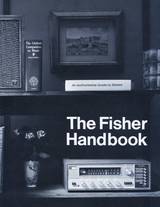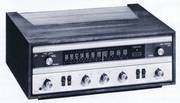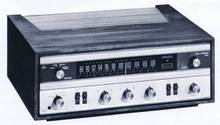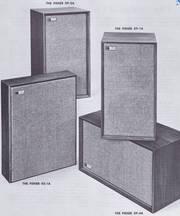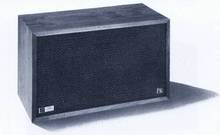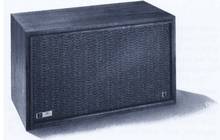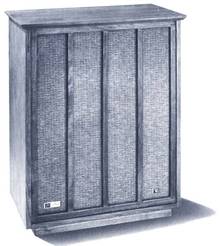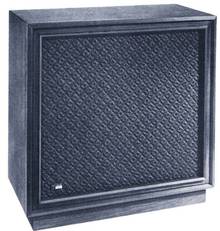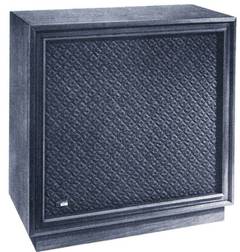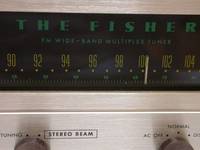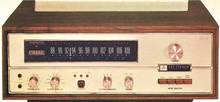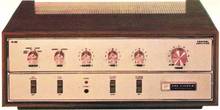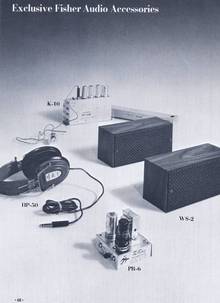Herbst 1967 - The Fisher Handbook - Teil 3 - die Geräte
Auch "The Fisher" hat es gemerkt, die modernen Hifi-Stereo Produkte sind erklärungsbedürftig und der Markt ist noch lange nicht reif, von allein zu kaufen. Die Interessenten, die überhaupt auf diesen Zug aufgesprungen waren oder gerade am Erkunden waren, brauchten Hilfe.
Diese schwarz-weiß Broschüre im amerikanischen B4 Format hat schon richtiges Geld gekostet, doch der gesamte amerikanische Markt stand offen und das waren nicht unerhebliche Möglichkeiten. Fisher hatte sich den bisherigen Hifi-Markt mit nur ganz wenigen Mitbewerbern geteilt, die dort im oberen Bereich überhaupt etwas Vernünftiges anbieten konnten.
.
Dieser 74seitige Prospekt, also das "The Fisher handbook", ist schon sehr ausführlich. Damit es überhaupt lesbar ist, hatte ich das in drei Teile zerlegt. Hier ist der Teil 3 mit den Fisher Geräten Frühjahr 1968.
.
Herbst 1967 - The Stereo Receiver
EVERYTHING YOU NEED ON ONE, BEAUTIFULLY INTEGRATED CHASSIS
Simply Add Two Speakers of Your Choice
Some people believe only a technically inclined individual can properly select a high-quality, precision-engineered high fidelity system. Nothing could be further from the truth.
Today anyone who can read and hear can quickly select an outstanding stereo high fidelity system. And installing a component hi-fi system is a great deal easier nowadays than putting up a TV antenna.
This simplification was achieved by combining all the many specialized components one required for stereo onto one, completely integrated chassis. This instrument is known as a Receiver, and the most popular components in the high fidelity industry are Fisher Receivers. With the purchase of a Receiver, all one needs to do is add a pair of speaker systems. Speaker cables can be connected to a Receiver in seconds.
All Fisher Receivers are matched to all Fisher Speaker Systems. The wide selection of Fisher Receivers and high-compliance Fisher Speaker Systems make it possible for one to 'personalize' a stereo system to any taste.
Fisher Receivers are available in moderately-priced, deluxe and luxury class models. Their circuitry is of tube, all-transistor or Integrated Circuit design, and are therefore available to meet the taste and budget of any music lover. Each model, regardless of cost, is designed to the highest standards in performance: they will not sound strikingly different. But they differ greatly in all other aspects, such as flexibility of control, power handling capacity, conveniences, number of input and output connections, physical size, engineering circuitry, and external appearance.
The Fisher 160-T™
40-Watt FM Stereo Receiver
Featuring TUNE-0-MATIC@ Instantaneous Touch Tuning
The Fisher 160-T is the world's first high-quality push-button FM Receiver. With it, you can select any of five FM stations at the press of a button, with perfect center-of'channel accuracy. You can tune any of its five vertical FM dials manually. You can connect tape recorder and phonograph and be assured of all the conveniences and program flexibility you would expect in a high-quality receiver, including a 3-way speaker selector and complementary front-panel headphone jack.
Best of all is the moderate cost of the 160-T, a price that places high quality stereo well within the reach of all.
Integrated Circuits and Field Effect Transistors, used in the tuner section's front-end and IF stages, afford the highest degree of reliability to assure years of superior trouble-free performance.
Automatic Frequency Control locks in the desired FM station, eliminating any mechanical 'off-center drift' that usually occurs in push-button car radios. Diode tuning assures this accuracy. Exclusive stereo beacon* automatically signals the presence of stereo and automatically switches to the stereo mode and back again.
In appearance as well as performance, the Fisher 160-T is unequaled and unique. Its magnificent gold-plated front panel maintains its new appearance for life. It has a built-in custom cabinet with sculptured walnut sides that lend a distinctive touch of elegance. No need to purchase an additional cabinet.
Weight: 15 pounds.
The Fisher l75-T™
65-Watt AM-FM Stereo Receiver
Everything you need for optimum enjoyment of AM and FM Stereo broadcasts has been combined in this beautifully integrated instrument to provide all the convenience, flexibility and ease of operation you would expect in a Fisher receiver.
As for performance, the all-new Fisher 175-T unfolds the world of stereo entertainment in a manner worthy of the most discerning audio connoisseur. Its capabilities outrank far costlier components.
The tuner section is a model of perfection, featuring the most advanced Integrated Circuits and Field Effect Transistors. Tuner sensitivity (IHF) is a remarkable 2.0 microvolts; selectivity (IHF), a high 45 db. The tuning convenience of Stereo Beacon* automatic mono/stereo switching and a signal strength-d'Arsonval meter are adjacent to the large, easy-to-read numbers on the AM and FM dial glass. With them, you can enjoy a broadcast in stereo without manually switching to the mode, and locate the exact center of the broadcast channel.
The Fisher 175-T is virtually unlimited in its capacity to shape and modify the texture of the sound to suit room characteristics. Baxandall feedback circuits in the bass and treble controls electronically maintain uniformity of response. A complementary Loudness Contour switch restores tonal balance of the lower bass and upper treble at low volume settings.
With 65 watts of music power (IHF), the Fisher 175-T has more than enough reserve to drive any speaker system to full volume. Separate main and remote speaker switches and a front-panel headphone jack provide enormous versatility in your listening pleasure. You can enjoy stereo in other rooms of your home by adding other fine Fisher speaker systems. If you prefer, you can turn off all speakers and enjoy stereo through the privacy of headphones without disturbing others in the same room. Whatever your choice, the 175-T delivers the musical program with the kind of super-sensitive control of sound and power that makes music a living reality in the home.
Weight: 18 pounds
Cabinet: Walnut (vinyl), 60-UW, Optional at Additional Cost
U.S. Patent No. 3290443
The Fisher 200-T™
70-Watt FM Stereo Receiver
Total performance means total reliability, and nowhere is one apt to find an instrument as capable as the new 200-T in providing years of high-performance, trouble-free service. In addition to its supersensitive Field-Effect Transistor front end, the tuner section incorporates four Integrated Circuits to perform the IF amplification, limiting and muting functions. Exclusive Stereo Beacon* signals the presence of stereo and automatically switches to the stereo mode, and back again.
With 70 watts of music power, the 200-T is capable of driving several pairs of speaker systems. For this reason, it features a four-way speaker selector to permit use of main, remote, or main and remote speaker systems. A full complement of tone controls and switches, including muting and loudness contour, have been logically grouped on a magnificent multitone, gold-bordered front panel that also affords tape and phono facilities, including Direct Tape Monitor.
A multiplex system of the time-division type provides maximum stereo separation. The two important tuning conveniences that make Fisher equipment such a pleasure to use are the illuminated tuning meter and the world-famous Fisher Stereo Beacon. The tuning meter is located at the right of the dial scale and makes accurate tuning extremely simple.
The audio controls feature a four-position Program Selector (Phono, FM, FM Local, Aux.). The auxiliary input can be used for an extra program source such as an AM tuner, the audio output of a TV set, etc. Dual bass and treble controls with Bax-andall feedback circuits and a balance control shape the texture and quality of the sound to suit room acoustics or any special condition.
For those who prefer private listening with headphones, the 200-T has a front-panel plug-in receptacle. There is even a switch to eliminate interstation hiss or noise on FM.
Fisher engineers have included a Tape Monitor circuit to permit one to compare the quality of the original program with that of the material being taped, so that immediate adjustments can be made quickly, without changing cable connections. This circuit also permits convenient tape playback.
Weight: 22 pounds.
Cabinet: Walnut, 50-UW, optional at additional cost.
The Fisher 250-T™
100-Watt AM- FM Stereo Receiver
The Fisher 250-T is a rare, masterful feat of engineering genius-a complete AM and FM Stereo Receiver with unusual flexibility in tuning and audio control, possessing enormous power reserve, a wealth of conveniences, and a standard of performance surpassing anything in its price class.
A brief look at its multi-tone front panel instantly tells you why the owner of the 250-T can well be proud of his investment. Its exterior has been tastefully designed with muted two-tone metal panels. Its easy-to-use flexible controls and switches are complemented by two separate modes of tuning: Tune-O-Matic® push-button selection on five separate FM dials, and the familiar flywheel control for conventional tuning along the extra-wide dial glass in the upper insert panel.
After pretuning each push-button to one of your favorite stations, the Tune-O-Matic® circuit permits you to select any of five FM stations at the press of a button, with perfect center-of-channel accuracy. Whatever your choice, Automatic Frequency Control (AFC) provides perfect center-of-channel tuning- electronically locks in the desired FM station. This is electronic diode tuning-totally different from and infinitely superior to mechanical push-button tuning.
The FM tuner front end has the high sensitivity, selectivity and overload rejection one would expect from advanced FET solid-state circuitry. By using Integrated Circuits (IC's) in the IF amplifier, all possibility of human error is eliminated in these circuits, thus assuring outstanding reliability. These IC's are equivalent to the use of four separate IF stages and three limiters. As a result, weak and distant stations you might never enjoy are now within easy reach. Even if you reside near a powerful FM transmitter, the 250-T's high overload capacity enables it to handle strong signals from that transmitter to assure optimum rejection of spurious response.
Stereo Beacon*, an exclusive Fisher achievement, automatically signals the presence of stereo and automatically switches to the stereo mode. The d'Arsonval tuning meter permits one to obtain perfect center of channel tuning with pinpoint precision. This signal-strength meter, arranged on a scale from 1 through 5, indicates the single best point for lowest distortion and maximum stereo separation of the desired signal.
The preamplifier section of the Fisher 250-T is a worthy complement to the tuner. Dual-concentric bass and treble controls, using Baxandall feedback circuits, permit the listener to adjust left and right channel independently to suit room acoustics or to compensate for tonal imbalances in program material. A loudness contour switch restores the natural tonal balance of the high and low ends of the audible spectrum at lowest volume settings. A muting switch eliminates FM interstation noise and hiss.
Its 100 watts of music power (IHF) are enough to drive several pairs of speaker systems. Its separate main and remote speaker push buttons provide all the convenience of a four-way speaker selector, but with greater ease. Turn all speakers off, if you like, and enjoy music in absolute privacy through headphones which plug easily into the front panel jack.
Weight: 19 pounds.
Cabinet: Walnut (Vinyl) , 60-UW, optional at additional cost.
U.S. Patent No. 3290443
The Fisher 500-T™
All-Transistor, 90-Watt FM-Stereo Receiver
Magnificent appearance, tremendous reserve power, reliable performance, unusually flexible audio controls-this winning combination of engineering and design features is why the Fisher 500-T is receiving the plaudits of the entire high fidelity industry, and why you have heard so much about this highly rated audio instrument.
The tuner and amplifier sections are models of perfection, and have all the attributes an audio professional would seek in two separate components. The tuner section incorporates the Super Synchrode front-end comprising three Field Effect Transistors, a two-stage RF section, four-gang variable capacitor, and six tuned circuits. It offers high overload capability and the suppression of spurious response. Weak and distant FM stations come in loud and clear, even in areas near powerful FM transmitters. The illuminated signal-strength meter and world-famous Stereo Beacon are tuning conveniences that are virtually indispensable.
The meter provides accurate tuning by indicating the point of maximum stereo separation and lowest distortion. The trademark, Stereo Beacon, signifies that the Fisher 500-T has the exclusive feature to automatically switch to the stereo mode, signal the presence of a stereo broadcast, and automatically switch back to mono again-according to the type of program being received.
Once the stereophonic audio signal is detected, it is fed into the superior time-division multiplex system. This circuit features an exclusive Four-Diode Coincidence Circuit to eliminate false triggering of the stereo mode due to noise pulses. Only a true stereophonic signal can activate the multiplex system.
Among the most important features of the Fisher 500-T are the specialized controls for Mode/Tape Monitor and Program selection respectively. The Mode/Tape Monitor can be used to select the precise operating mode for the amplifier section, or playback mode for tape decks, tape cartridge players or tape recorders. The six-position Program selector permits one to tape record any program source and know that the performance will be a superb reproduction of the original material.
Four switches, to modify and control the audible sound, attest to the versatility of the instrument. Loudness Contour restores the tonal balance of lower bass and upper treble. These normally tend to thin out at lower volume settings. The Muting Switch removes hiss, static and other interstation noise on FM as one tunes in along the dial. The High Filter switch removes annoying high-frequency noise from any program source (usually scratchy records). The Main/Remote Speaker Switch is generally used in conjunction with the headphone jack. It is designed for those who prefer to listen to stereo in complete privacy without disturbing others in the room, or who prefer a choice of listening to music in the main installation or remote area-the den and living room, or bedroom, for example. With 90 watts of power to draw on, the Fisher 500-T can drive the most inefficient speaker systems to full room volume.
Dimensions: 16%" wide, 5%" high, 12%" deep (maximum depth from control knobs to rear heat sink).
Weight: 21 pounds.
Cabinet: Walnut, Model 100-UW, optional at additional cost.
The Fisher 550-T™
All-Transistor, 90-Watt AM-FM Stereo Receiver
The best of AM and FM stereo reception, on one beautifully integrated chassis of ultrasophisticated design, has been incorporated in the new Fisher 550-T. For those who seek exceptional value, the most up-to-date circuitry, and the enjoyment of every type of musical program, here is the prize that wins the plaudits of the high-fidelity industry.
The Fisher 550-T has 90 watts of undistorted power, utilizes seven separate Integrated Circuits and two Field Effect Transistors in its tuning section, and has unlimited control flexibility for recreating the world of AM, FM, tape, phono, and other auxiliary sources such as TV and movie sound projectors.
Thanks to the miracle of Microcircuitry, this superb performance is well within the reach of all. The super-sensitive Field Effect Transistor front end is followed by six of these new ICs. These Microcircuits - no larger than this "o"-perform the important functions of IF amplification and superior limiting. A seventh Integrated Circuit is utilized for muting and for controlling the d'Arsonval tuning meter. The world famous Stereo Beacon automatically signals and switches from stereo to mono reception.
The new AM section, with greatly improved sensitivity and selectivity, has also been included. It has low distortion characteristics, comparable almost to the superb FM tuner section.
The amplifier section has the fullest complement of controls and switches for shaping the sound of tape, phono, AM and FM to the needs of the listener. The new four-way speaker selector adds new flexibility to a unit that is far above others in versatility. With it, one can listen to speaker systems in the main installation, remote, both or none. In this fourth (off) position, the listener can enjoy the musical program through headphones that plug easily into the front-panel jack. A center channel output is provided to drive a center speaker to eliminate the 'hole-in-the-middle' effect of some listening areas.
Every known and desirable engineering advancement in solid-state and Microcircuit design has been incorporated in this remarkably compact, easy-to-use stereo receiver. Among the host of reliable, highly efficient circuits are several that were developed for use in aerospace technology.
The Fisher 550-T is a worthy addition to the home -the finest AM-FM receiver one can own. For the audio professional, the sophisticated music lover, and the discerning newcomer who seeks high quality, the Fisher 550-T warrants serious consideration and admiration.
Dimensions: 16" wide, 5" high, 15" deep (maximum depth from control knobs to rear AM antenna in extended position).
Weight: 29 pounds.
Cabinet: Walnut, Model 100-UW, optional at additional cost.
The Fisher 700-T™
All-Transistor, 120-Watt FM-Siereo Receiver
The Fisher 700-T sets the standard of excellence in high fidelity receivers. By whatever criterion one chooses-range of operation, breadth of control flexibility, over-all performance, undistorted high power -this instrument is without precedent. Its extraordinarily magnificent appearance-contrasting bands of walnut-textured and anodized panel inserts set against a 14-carat gold-plated front panel - dramatically underscores what many consider to be the finest home entertainment instrument ever made.
The 700-T has 120 watts of music power (IHF), a mighty reservoir capable of driving a number of speakers in a large auditorium as well as speaker systems in many other rooms of the home. A four-position Speaker Selector permits one to use speakers in the main or remote installation, or both, or in the privacy and comfort of headphones that plug into a receptacle on the front panel. A center channel output for a 'third' or remote speaker is included. This eliminates the problem of a "hole in the middle" that occurs when speakers are separated too widely. In addition to the group of silicon Field Effect Transistors, the 700-T employs twenty-two low-level and power silicon transistors.
This instrument features the Super Synchrode® front end, with three Field Effect Transistors, two stages of RF amplification, six tuned circuits and a four-gang variable capacitor. This outstanding circuit has increased the sensitivity of the tuner section to its theoretical limit and enables it to intercept the weakest of FM signals. Four IF stages, three limiters and a wide-band ratio detector have been incorporated for maximum freedom from noise and interference.
A Four-Diode Coincidence Circuit, to eliminate triggering caused by spurious signals, has been included in the time-division multiplex section. In this way, only the true stereo signal can trip the mono-stereo switch. The overall circuit of this multiplex system produces stereo separation that reaches the limits of perfection. For tuning ease and convenience, Fisher engineers have included an illuminated signal strength tuning meter, and world-renowned Stereo BEACON+.
Specialized controls include a six-position program selector (Tape Head, Phono, FM Auto, FM Stereo, FM Mono, Aux) and a supposition Mode Selector (Mono, Stereo Filter, Stereo, Stereo Tape, Tape L, TapeR).
The unique Direct Tape Monitor allows quick adjustment of any tone control or switch, without changing cable connections. As a result, the material one records on tape can be completely free of noise, distortion, or other interference.
In its last two positions, Tape L and Tape R, one can playback each of four tracks of a monophonic tape through both loudspeakers simultaneously.
Four switches are centrally located on the front panel for instant use in modifying the sound. The Loudness Contour control equalizes volume at very low and very high frequencies. The Low and High Filter switches suppress low-frequency and high-frequency noise respectively. The Muting switch eliminates annoying noise between stations. The most elaborate electronic equipment now used by professionals palls in comparison to this remarkable instrument. It is truly spectacular in performance.
Dimensions: 16" wide, 5" high, 12" deep (maximum depth from control knobs to rear heat sink).
Weight: 24 pounds.
Cabinet: Walnut, Model 100-UW, optional at additional cost.
.
The Fisher 400™
65-Watt FM-Stereo Receiver
The Fisher 400 has long been favored by the newcomer and hi-fi enthusiasts alike, who prefer an instrument with substantial power at an unusually modest cost. It embodies the best in electrical wiring workmanship and audio engineering, and its rugged tube circuitry affords virtually unlimited years of trouble-free service.
There has been no compromise in the essential design characteristics, or in the rigorous test procedures and standards of the 400 since its introduction. Circuit improvements and refinements have, of course, been made continuously. The gradual upgrading of an already fine instrument, coupled with a substantial reduction in manufacturing costs, has resulted in reproducing equipment of outstanding value for the economy-minded music lover.
The Fisher 400 incorporates a high-sensitivity FM-Stereo tuner, a flexible stereo preamplifier, and a 65-watt (IHF) stereo power amplifier. The front-end section employs three tuned circuits for increased selectivity, thus permitting the user to tune in a far greater number of FM stations than he might expect with ordinary FM equipment. To heighten the sensitivity of the instrument so that even the weakest FM signal is brought in enjoyably, Fisher engineers have included four wide-band IF stages, and three stages of limiting. The ratio detector, utilizing a matched pair of germanium diodes for linear performance over an extremely wide range, is capable of detecting and transmitting the most complex stereo-multiplex signals and reproducing them without distortion.
The multiplex demodulator features the superior time-division method. This system, best for producing maximum stereo separation, is one of several circuit designs Fisher engineers have incorporated in this
model. Another is Stereo Beam, the Fisher trademark that signifies the Fisher 400 has the convenience feature of automatically signaling the presence of a stereo broadcast. It is also used as a tuning indicator for microaccurate tuning of mono and stereo broadcasts.
The audio control center of the 400 has all the desired features, including tone and balance controls, loudness compensation^ sharp-cutoff high frequency filter, and a speaker on-off switch. In addition, the exclusive Fisher Direct Tape Monitor has been incorporated to provide monitoring of tape recordings, followed by immediate playback, with unrestricted use of all audio controls.
The Mode/Program Selector has seven positions (Tape Head, Phono Mono, Phono Stereo, FM Stereo, FM Stereo Filter, FM Mono, Aux-Tape) to afford easy access to any program source. Other extras include a center-channel output (for a separate power amplifier), choice of normal or local antenna inputs to prevent overloading on strong local signals, and DC on all filaments of the low-level audio stages to reduce hum and noise to the vanishing point.
Although the 400 would appear to be ideal for those with a very limited budget, many audio enthusiasts have found the 400 to be ideal for their critical needs. It epitomizes the very best qualities of Fisher engineering - exceptional performance, breadth of flexibility, ease of operation, and an abundance of power, capable of driving several pairs of speaker systems.
Weight: 30 pounds. Cabinet: Walnut, Model 30-UW, Optional at additional cost.
Herbst 1967 - The Speaker System
HIGH-EFFICIENCY, HIGH-COMPLIANCE SOUND REPRODUCERS
An electronic device, such as an Amplifier or Tuner, merely transmits an electrical signal that is scientifically measurable, but not yet audible. The speaker must process and convert the signal to audible sound so that your ears may hear precisely what is being broadcast, taped or recorded. That is why a high-quality stereo system is only as good as its speaker system, and why it is best to select the finest loudspeaker system possible, within budget and physical space limitations.
Of all the standards used in rating speaker performance, the two most useful criteria are Efficiency and Compliance. Efficiency is a unit of measurement relating to the amount of electrical power required to produce a given amount of acoustic power. Compliance is the degree of freedom required by a speaker cone in order to properly reproduce the audible range. All Fisher speaker systems, regardless of size or cost, have been designed with both exceptionally high efficiency and high compliance. As a result, all Fisher speaker systems have a natural-sounding resonance-free character.
The FisherXP-44™
Little Giant® Free-Piston Speaker System
The new Fisher XP-44 is the smallest and least expensive speaker system in the Fisher line. A pair of '44s can fit into any area, for they occupy a space no larger than that afforded a few books. In spite of its compact size, the XP-44 has a completely natural and effortless sound quality.
This new Little Giant® contains all the elements required for incomparable performance. It has a high-compliance six-inch bass speaker with a two-pound magnet structure and one-inch voice coil. Free-air resonance is 40 Hz - unusually low for a speaker of such small size.
The upper-middle and extreme high frequencies above 1000 Hz are reproduced by a 21/2-inch speaker. This unit has a specially constructed low-mass cone and is designed to disperse sound evenly in all planes. Its capacity to sustain the ultra high frequencies without coloration contributes greatly to its natural sounding quality.
The XP-44 has a rich walnut vinyl finish with matching interwoven tweed-like grille cloth. It is the ideal second speaker system for the music lover who requires additional speaker systems for other rooms of the home. And it is ideal as a first speaker system for those seeking outstanding tone quality in limited space for equipment.
Overall, the Fisher XP-44 is indeed a Little Giant®-a small, yet enormously powerful unit that reflects Fisher quality in design and workmanship.
Frequency Response: 39 to 19,000 Hz
Recommended Amplifier Power: 10 to 25 watts - Impedance: 8 ohms
Dimensions: 8" X 15" X 6 1/2" deep - Weight: 15 pounds
Cabinet: Walnut (vinyl)
.
The FisherXP-55B™
Compact Free-Piston Speaker System
The new Fisher XP-55B is perfect proof that it is possible to attain fine sound with a moderate-sized speaker system. For although this system is small and inexpensive, it has the high-compliance suspension mechanism and high efficiency of a professional-quality enclosure.
The XP-55B is significantly better than any system of comparable size. It delivers the full audible spectrum without a trace of distortion throughout its range, whether at the extremely low or high ends of the audible spectrum.
Although its compact cabinet measures only 10" X 20" X 7 1/2" deep, it incorporates two precision transducers matched for optimum performance-a massive eight-inch bass speaker, supplemented by a three-inch treble speaker with a crossover network at 1500 Hz.
The XP-55B employs an entirely new bass driver whose performance is very close to that of large speakers, at the same time, requires no artificial correctives such as shaping networks which tend to alter the bass ^output of the amplifier. This woofer is eight inches in diameter, incorporates a two-pound magnet structure and a totally new suspension system featuring extra-wide-excursion and a half-roll surround.
The three-inch treble speaker reproduces frequencies from 1500 Hz to beyond audibility. It features a new low-mass cone made of a combination of special fibrous materials. This results in peak-free response out to 20,000 Hz without distortion or coloration.
As its modest cost, the Fisher XP-55B represents an unusual value in loudspeakers, and will be a noteworthy addition to any high fidelity system.
Frequency Response: 37 to 20,000 Hz
Recommended Amplifier Power: 10 to 30 watts - Impedance: 8 ohms
Dimensions: 10" X 20" X 7" deep - Weight: 18 pounds
Cabinet: Walnut (vinyl)
The Fisher XP-60™
Two-Way Bookshelf Speaker System
Extreme clarity, precise transients, full and rich texture-these are among a host of performance features of the Fisher XP-60. These features reflect a high-quality sound reproducing system - a comparatively low-cost Fisher bookshelf with all the notable engineering characteristics of Fisher engineering.
Its ten-inch free-piston bass speaker utilizes a four-pound magnet structure, an extremely compliant cone surround, and a l^-inch voice coil diameter. The woofer has a free-air resonance of 30 Hz, unusually low for a transducer of this size, and indicative of its capacity to reproduce the lowest tones with astonishing purity and without any distortion.
The 21 inch mid-range/treble speaker has a low-mass cone and high internal damping. It has wide-dispersion characteristics and affords clear, natural highs without coloration or shrillness. The XP-60 is just under two cubic feet, and its two transducers perform with precision, or absolute smoothness of response.
The Fisher XP-60 is highly recommended for those who seek an outstanding system at comparatively modest cost. When used with an amplifier of good quality, the XP-60 achieves astonishing realism. Complete transparency of tone greets the listener, and one is immediately struck by the quality of 'presence,' a steady, uncolored, and full flow of sound, is clear, precise and unwavering.
Frequency Response: 35 to 20,000 Hz
Recommended Amplifier Power: 10 to 40 watts - Impedance: 8 ohms
Dimensions: 13" X 23" X 7" deep - Weight: 30 pounds
Cabinet: Walnut (vinyl)
.
The Fisher XP-6B™
Bookshelf Speaker System
Few accomplishments in speaker design in the last few years are equal to those incorporated into the Fisher XP-6B. This system is the only two-way unit with nearly all the essential characteristics of a standard three-way bookshelf speaker system. It offers extreme clarity, the precise reproduction of transients throughout the audible spectrum, and flat, natural sound without coloration in the 'highs' or 'lows.'
Bass and lower mid-frequencies are reproduced by a 10-inch free-piston bass speaker. It has a long-throw voice coil, 5-pound magnet structure, and an extremely compliant half-roll surround. The cone material and the use of a special chemical treatment for both cone and surround result in a woofer with a free-air resonance of 22 Hz, unusual for a transducer of this size.
The 2 1/2-inch mid-range treble speaker has a low-mass cone and high internal viscous damping to achieve excellent transient response. The XP-6B is just under two cubic feet, and its two transducers are accurately matched to the enclosure for overall smoothness of response. The XP-6B is unhesitatingly recommended for those who seek a superb performer at moderate cost, and who have sufficient bookshelf space to accommodate such a unit.
Frequency Response: 32 to 19,000 Hz
Recommended Amplifier Power: 10 to 50 watts - Impedance: 8 ohms
Dimensions: 13" x 23" x 10" deep - Weight: 35 pounds
Cabinet: Oiled Walnut
The Fisher XP-7™
Free-Piston 3-Way Speaker System
The Fisher XP-7 is a three-way speaker system with four loudspeakers: a massively-built 12-inch bass driver, two identical, linear-matched 5-inch mid-range speakers, and a 1 1/2-inch wide-dispersion treble speaker with exclusive soft-cloth, dome-shaped construction. In a comparatively short time since its introduction, the XP-7 has been awarded more top-level ratings from important national consumer magazines than any system of comparable size and cost.
Each of the two mid-range drivers are housed in separate, tightly sealed compartments to prevent interaction among bass and mid-range. This 'speaker-within-a-speaker' design is responsible for a full-bodied, in-phase sound.
The bass speaker has a 5 1/2-pound magnet structure and a voice coil diameter of 1 1/2 inches, all tending to eliminate distortion that might ordinarily occur at high volume levels, or in the reproduction of bass tones of 30 to 40 Hz. The outside surround is impregnated with a non-drying butyl liquid, thus providing exceptional compliancy to the cone, and enabling the bass to reproduce frequencies of 30 Hz without doubling or overshoot.
A low-loss 12 db-per-octave inductive-capacitive crossover network controls the frequency separation at 300 and 2,500 Hz.
Few speaker systems, at any price, even compare to the magnificence of the Fisher XP-7. Its flat, smooth and neutral character reflects the finest in speaker engineering.
Frequency Response: 30 to 20,000 Hz
Recommended Amplifier Power: 10 to 60 watts - Impedance: 8 ohms
Dimensions: 14" x 24" x 12" deep - Weight: 45 pounds
Cabinet: Oiled Walnut
The Fisher XP-66™
Free-Piston 3-Way Speaker System
A three-way speaker system of bookshelf size has been designed by Fisher Laboratories for those who prefer high quality at moderate cost. Its smooth, balanced sound can be attributed to the use of premium-grade transducers and a laboratory-matched crossover network.
The 12-inch high-compliance free-piston bass speaker handles frequencies down to 30 Hz without distortion or doubling. Transient response of the lower frequencies is assured by the use of a 5-pound magnet structure and butyl-impregnated half-roll surround.
The mid-range portion of the audio spectrum is reproduced by a six-inch speaker which is sealed off from other elements of the system by a sub-enclosure. This prevents acoustic interaction between mid-range and woofer.
Extremely high frequencies are less likely to radiate uniformly in all directions. For this reason, Fisher laboratories have designed a wide-dispersion cone-type treble speaker. Because of its low-mass cone, the speaker achieves excellent transient response up to the limits of audibility. It is constructed of a special fibrous material, and is highly damped to eliminate annoying distortion caused by cone resonance and breakup to provide outstandingly smooth reproduction of the "highs."
Frequency separation at 400 and 1,000 Hz is controlled by a low loss 12 db per-octave inductive-capac-itive crossover network. The tightly-sealed enclosure is constructed from heavily-braced sheets of dense, non-resonant material with bonded walnut veneers.
Frequency Response: 30 to 19,000 Hz
Recommended Amplifier Power: 10 to 60 watts - Impedance: 8 ohms
Dimensions: 14" x 24" x 12" deep - Weight: 40 pounds
Cabinet: Oiled Walnut
The Fisher XP-9B™
Free-Piston 4-Way Speaker System
The significant difference in this loudspeaker system is one which becomes instantly apparent when you hear it. For the first time, a system has been designed to split the full-frequency range into four sections rather than the customary three. The bass speaker, with its compliant cone and heavy magnet structure, concentrates solely on frequencies from 28 to 300 Hz; the 6-inch lower mid-range reproduces frequencies of 300 to 1,000 Hz; the 5-inch upper mid-range from 1,000 to 2,500 Hz; and the 1 1/2-inch soft dome, wide-dispersion treble speaker reproduces frequencies from 2,500 Hz to beyond audibility.
This four-way crossover network removes all likelihood of distortion or tonal imbalance in the sound reproduction of the original program. Audible response is amazingly uniform and natural-crystal clear in the highs, smooth and transparent in the mid-frequencies, clean, tight and solid in the lows. Each speaker in the system is isolated, to avoid interaction between bass and mid-range units. The three-position treble balance control, located at the rear of the speaker system, allows you to adapt the texture of the upper frequencies to the acoustics of the room.
The elaborate all-electrical crossover design has precisely wound coils and capacitors to filter out those frequencies that are above or below a particular driver's operational limit without losses.
Frequency Response: 28 to 22,000 Hz
Recommended Amplifier Power: 10 to 60 watts - Impedance: 8 ohms
Dimensions: 14" wide x 24" high x 12" deep - Weight: 60 pounds
Cabinet: Oiled Walnut
The Fisher XP-10™
Consolette 3-Way Speaker System
In its smoothness, transient response and overall musical quality, the Fisher XP-10 borders on absolute perfection. The bass speaker is a mammoth 15-inch transducer with a 6-pound magnet structure and voice coil diameter of 2 inches. Even the lowest bass tones are flawlessly reproduced, regardless of amplitude. The mid-range speaker is eight inches in diameter - larger than the bass speaker in some economy models. As a result of its extraordinary size, this speaker can handle the entire range of mid-frequencies from 200 to 2,500 Hz with spectacular ease. To avoid acoustic interaction, the mid-range unit is housed in a separate, air-tight sub-enclosure heavily padded with Acoustiglas.
The high frequencies are reproduced by a peripherally driven, hemispherical treble speaker that has a soft-cloth dome bonded directly to the light copper voice coil.
Frequency Response: 28 to 20,000 Hz
Recommended Amplifier Power: 10 to 60 Watts - Impedance: 8 ohms
Dimensions: 30" high, 24" wide, 14" deep - Weight: 80 pounds
Cabinet: Oiled walnut
The Fisher XP-12™
Console Three-Way Speaker System
The remarkable new Fisher XP-12 sets an entirely new standard of excellence in performance and quality. It incorporates many of the latest engineering advancements pioneered by Fisher, to provide sound reproduction that must be heard to be believed.
Three acoustically-matched transducers have been incorporated in a system that features only the finest components and materials.
The 12-inch bass speaker has a six-pound magnet structure. Its extremely compliant surround is combined with a specially prepared cone material to afford wide excursion and smooth, resonance-free response. The system has a low bass-to-mid-range crossover of 400 Hz, thus permitting the bass speaker to operate at peak efficiency in the lower three octaves of the audible spectrum.
The eight-inch mid-range speaker has been specially designed for this consolette speaker system. It reproduces frequencies between 400 and 2500 Hz with flawless fidelity.
The treble speaker is a wide-dispersion 1 1/2" hemispherical soft-dome type*, providing pure, uncolored sound to beyond the limits of audibility.
Each of these elements, including low-loss inductive-capacitive crossovers at 400 and 2500 Hz, have been tailored to the physical size of the system. Every nuance of the musical program-from the lowest bass tone to the highest tones of the flute - are reproduced with astonishing purity and presence. All in all, the new Fisher XP-12 is worthy of the most discriminating music devotee.
Frequency Response: 30 to 20,000 Hz
Recommended Amplifier Power: 10 to 50 watts - Impedance: 8 ohms
Dimensions: 24" high, 22" wide, 13" deep - Weight: 60 pounds
Cabinet: Oiled walnut
The Fisher XP-15B™
Consolette Three-Way Speaker System
Every hallmark of fine Fisher engineering and design-magnificent styling, precise transient response, exceptional tight and solid lows that will not muddy even at 28 Hz - have been incorporated in an instrument of exact proportion.
The new Fisher XP-15B is a speaker system that extends beyond the bounds of mere professionalism. It is truly a model of perfection in every detail. The fifteen-inch bass speaker features a unique half-roll surround of extreme compliancy as well as a massive 12-pound magnet structure and 21/£-inch diameter voice coil. Such oversized and conservatively rated materials assure the speaker's capacity to perform perfectly within its assigned frequencies of 28 to 400 Hz.
The eight-inch mid-range speaker-a size considerably larger than bass drivers in other units-reproduces the frequencies between 400 and 2500 Hz. The 1 1/2-inch hemispherical treble speaker utilizes a soft-dome diaphragm* that has excellent dispersion characteristics. Transient response is also unsurpassed because of the unusually high flux density of the tweeter magnet structure and the low-moving mass of the tweeter diaphragm.
A tweeter level control has been incorporated at the rear of the instrument. This calibrated three-step type permits one to boost the high frequencies when necessary, or reduce the emphasis on the treble tones to suit the acoustical environment of the room. The new Fisher is of handsome appearance and will blend perfectly with any home decor.
Frequency Response: 28 to 20,000 Hz
Recommended Amplifier Power: 10 to 60 watts - Impedance: 8 ohms
Dimensions: 27" X 27" X 14" deep - Weight: 80 pounds
Cabinet: Oiled walnut
The Fisher XP-18™
Consolette Four-Way Speaker System
When the performance goals were established for the design and development of the Fisher XP-18, foremost among them was the aim to produce a speaker system totally free of coloration. Such a unit was to be of 'transparent' quality, imposing nothing of itself between the signal source and the listener. The Fisher XP-18 has met these goals to a degree even beyond our highest expectations.
Heart of the speaker complement is a massive 18-inch bass woofer-the largest high quality loudspeaker ever designed for home use. It is capable of handling frequencies down to 14 Hz (2 cycles below the lowest organ tone in the world) and has overwhelming power handling capacity. Its 2-inch voice coil operates in a 12%-pound magnet structure, providing critical magnetic damping that produces an amazingly solid, non-resonant bass, covering the range from 14 Hz to 150 Hz.
An 8-inch lower mid-range unit reproduces the frequencies between 150 and 1500 Hz. Like the bass speaker, the lower mid-range unit is sealed in its own sub-enclosure to prevent acoustic interaction with other speakers in the system. Its upper mid-range unit is a smaller, 5%-inch free-piston speaker in a vented sub-enclosure. The upper mid-range speaker reproduces frequencies from 1500 to 3000 Hz.
The upper limits of the audible spectrum are handled by two linearly matched 2-inch treble speakers.
Frequency Response: 30 to 22,000 Hz
Recommended Amplifier Power: 10 to 60 Watts - Impedance: 8 ohms
Dimensions: 29" high, 30" wide, 16" deep - fTeight: 105 pounds
Cabinet: Oiled walnut
Herbst 1967 - The Tuner
HIGH SENSITIVITY FM and AM-FM STEREO TUNERS
The development and design of a fine tuner is the most complex of all projects one can assign an audio engineering staff. It must have the capability of locating, sensing, and converting signals that are normally measured in a few millionths of one volt into enjoyable and useful dimensions measured in many times their original power.
The advent of FM-Stereo multiplex programs and the solid state circuitry now available have accelerated both the complexity and opportunity for brilliant design.
Since the dawn of the high fidelity era, Fisher tuners have been recognized as the finest in the world. They can be found in hundreds of American and foreign broadcast stations, including the world-renowned Royal Telecommunications FM Network of Sweden. The selection of the Fisher Tuner is based on the consistent, reliable and unparalleled performance it offers, especially in its Sensitivity and Selectivity. The first is the measure of a tuner's capacity to sense the presence and enlarge to usable form weak signals from the broadcast station. This capacity is measured in microvolts (millionths of a volt). The lower the figure, the finer the tuner. Selectivity represents the capacity of the tuner to receive the station it has selected perfectly, without interference from other stations. Selectivity is measured in decibels. The higher the number, the better the tuner.
The Fisher R-200-B is the world's first high fidelity tuner that offers facilities for the reception of regular AM broadcasts, shortwave stations, and weather and navigation longwave, in addition to matchless FM reception. It offers the music lover direct access to cultural centers throughout the world.
The crowning gem of all Fisher tuners is the Fisher TM-1000. There is no other like it in all the world, for it incorporates seven exclusive circuit features that will set the standard of performance for years to come.
The Fisher R-200-B™
All-Transistor FM-Stereo, AM, Short Wave Tuner
Wherever you go, wherever you are, the Fisher R-200-B will keep you in touch with the news and music of the world. A newscast from London, a concert from Paris, a weather report from Singapore- all the cities of the globe can be tuned in with miraculous presence with this remarkable FM-Stereo, AM and Short Wave tuner.
The Fisher R-200-B is the ideal tuner for those who seek world-wide entertainment programs. Its sensitivity and selectivity approach the theoretical limits of tuner capability.
The instrument has five frequency bands for the reception of FM-Stereo, standard AM, weather and navigation, 41-meter to 19-meter short wave, and a 49-meter short wave bandspread scale. Nineteen tuned fixed circuits provide maximum efficiency and stability. Even under adverse conditions, it will operate magnificently, regardless of geographic location.
The high-sensitivity FM section features a new version of the Fisher Golden Synchrode front end for high overload rejection. Another feature of the FM section is Stereo Beacon, a Fisher trademark and patent, that signifies that the R-200-B has the convenience feature of automatically switching to the stereo mode, signaling the presence of a stereo broadcast, and automatically switching back to mono again-according to the type of program being received.
Highest selectivity is maintained by using a tuned AM-RF stage and a three-gang AM tuning capacitor. The Automatic Gain Control (AGC) smooths out variations in signal strength, and minimizes slow or fast fading, particularly important on short wave reception.
The large AM ferrite antenna has a static shield to make it virtually insensitive to man-made, electrical interference. An external wire antenna is included for long distance reception of all bands, especially short wave.
The Fisher R-200-B has facilities for optimum performance both in the United States and abroad. A multi-tap transformer permits operation of the tuner on 50 to 60 Hz power lines from 100 to 135 volts, and 200 to 250 volts.
Controls include Band Selector (FM, MW, LW, SW, 49M); AM Bandwidth (Sharp, Normal, Wide); FM Stereo Mode (Mono, Auto, Stereo); FM Muting; Power (AC Off, On) ; Tuning.
Dimensions: 15" wide, 41" high, 14" deep (maximum depth from control knobs to rear antenna in extended position). - Weight: 18 pounds.
Cabinet: Walnut, Model 50-UW, optional at additional cost.
The Fisher TFM-1000™
Laboratory-Standard, All-Transistor FM-Stereo Tuner
The TFM-1000 is the first FM-Stereo tuner with absolutely perfect facilities for receiving FM broadcasts. It is in every way the ultimate tuner. It has no traceable distortion. It will not overload. It represents a giant stride beyond all previous conceptions as to what an FM tuner should be, and what it must be able to do.
The Fisher TFM-1000 has seven exclusive all-transistor circuits - more engineering 'firsts' than have ever before been incorporated in a single high fidelity component. These unique features are largely responsible for the unprecedented degree of excellence at every level-performance, flexibility, ease of operation, reliability, and elegant appearance.
The SUPER SYNCHRODE front-end uses silicon field effect transistors (FET's) for suppression of spurious response and high overload capability. The double-shielded front-end has two RF stages, a four-gang variable capacitor, and six tuned circuits. This front-end module is one of the most significant engineering achievements in the instrument. It attains the highest known overload capability, selectivity, and rejection of spurious response to a degree in excess of 100 db! To bring the sensitivity of the Fisher TFM-1000 to its theoretical limit, a total of five IF stages and four limiters have been incorporated. A unique overload suppressor circuit automatically holds the signal strength of the FM signal within a range that can be easily handled. It is created by the combined action of an automatic RF attenuator with that of a wide-band attenuator in the IF strip. The result is to give the TFM-1000 a dynamic range superior to that of any FM tuner ever produced.
The most revolutionary feature of this instrument is the counter detector demodulator with symmetrical hard limiters. This exclusive limiter and detector circuit was, from its inception, developed to the most exacting specifications. It completely eliminates distortion and achieves the remarkably low capture ratio, never before attained, of 0.6db. It has no tuned circuits and is therefore not subject to drift. As a result its unparalleled performance will be maintained indefinitely.
The four-diode coincidence circuit used in the time-division multiplex section eliminates triggering caused by spurious signals. Only the true signal can trip the mono-stereo switch. Separation reaches the limits of perfection. At 1kHz, it is more than 40db; at 15kHz, it is better than 30db.
The push-button-operated clear signal indicator shows the relative purity of received FM signals. It is an invaluable tool for orienting rotatable antennas.
A new power amplifier circuit has been incorporated in the tuner. The balanced transformer-driven outputs provide sufficient audio power for high quality, low-impedance headphones. Either low or high-impedance headphones can be plugged into the front panel for use with a separate volume control. Separate transformer windings provide additional balanced 600-ohm outputs for professional use.
By any standard, there is no finer tuner in all the world. The Fisher TFM-1000 has been designed exclusively for those discriminating music lovers who demand absolute perfection.
Dimensions: 16" wide, 5" high, 12" deep (maximum depth from control knobs to rear fuse post). - Weight: 18 pounds.
Cabinet: Walnut, Model 100-UW, optional at additional cost.
Herbst 1967 - The Amplifier
HIGH RESERVE POWER and FLEXIBLE AUDIO CONTROLS ON SEPARATE OR INTEGRATED CHASSIS
The control-amplifier is the heart of a high quality stereo system. Its twofold function is to amplify the signal to the desired audible level, and to control the brightness and body of the sound, with the separate bass and treble tone controls. The loudness control maintains the desired relationship between bass and treble, even at low volume settings where ordinarily extreme bass and treble tone tends to thin out and disappear. (Human hearing is more uniformly efficient at higher volume levels).
At the outset, a fine high fidelity system may comprise a control amplifier, a pair of speakers, and a turntable or record changer-a combination obtainable at surprisingly modest cost. One can, at a later date, add a high-quality tuner, or tape recorder, or both, and thus enjoy unlimited freedom in selecting original program material.
In general, it is wiser to build gradually, with components of higher quality, than quickly with components of lesser quality. Good equipment can be expected to last twenty-five years, making the difference in cost between ordinary equipment and superb equipment relatively small.
Fisher control-amplifiers cover a wide range of reserve power and control flexibility. All Fisher amplifiers more than meet the requirements of the average home, with sufficient reserve for the addition of speakers in other parts of the home.
.
The Fisher TX-1000™
For those who seek an exemplary instrument in audio power and control, Fisher presents the TX-1000 - a 120-watt control-amplifier with the most sophisticated and reliable circuitry ever conceived for use in a high fidelity component. It has more power, more audio control and more pure performance than any other component at any cost, and is winning the accolades of all audio connoisseurs.
It features push button controls for speaker selection, filters and loudness contour. Its plug-in jacks for tape and phones, located on the lower insert of a magnificent gold-plated front panel, add an extra measure of convenience. With the headphone jack, one can enjoy the musical program in privacy, without disturbing others in the room.
The six-position program selector permits a choice of microphone, tape, phono, tuner, and includes inputs for reception of the audio portion of two auxiliary program sources, (i.e. telecast, movie, etc.) The separate Tape Monitor selector features Left and Right positions to facilitate playback of each of the four tracks of a monophonic tape through both loudspeakers simultaneously. Its Direct Tape Monitor feature permits one to instantly check the quality of the material being taped and make adjustments without changing cable connections.
The center channel output is an added feature to enable one to drive a third or remote speaker system. With 120 watts of music power (IHF), the new Fisher TX-1000 has more than adequate reserve to drive speaker systems in other rooms of the home.
Not only is this instrument the ideal for the most critical audiophile, but is definitely the most logical choice for the newcomer who can afford the luxury of the finest in enjoyment of records and tape.
This powerful and flexible instrument is the most reliable component in the high fidelity industry. Its all-silicon transistor circuitry is designed to operate smoothly under all operating conditions. This assurance of superb, trouble-free performance more than compensates for its higher cost, for it promises virtually unlimited years of service.
Dimensions: 15" wide, 4" high, 12" deep (maximum depth from control knobs to rear heat sink). - Weight: 24 pounds.
Cabinet: Walnut, Model 50-UW, optional at additional cost.
The Fisher TX-100™
65-Watt All-Transistor Stereo Control Amplifier
The Fisher TX-100 is the first high-quality, all-transistor control amplifier available at a budget price. This reliable instrument provides more pure undistorted watts per dollar than any other instrument on the market today. Its total output-65 watts of music power (IHF) -is more than enough to drive additional speaker systems in other rooms of the home. Its flexibility of controls rivals many professional-quality units.
These include a four-position Program Selector (Tape Head, Phono, Tuner, Aux) and a two-position Mode selector (Mono/Stereo), as well as matched volume, balance, bass, and treble controls.
The front-panel headphone jack, coupled with the use of a main/remote speaker switch, permits one to enjoy music in other rooms of the home, or in private, without disturbing others in the same room. The Loudness Contour switch automatically increases volume of the very low bass andtreble tones to an audible level, and recreates the proper tonal balance of treble and bass. The exclusive Fisher Direct Tape Monitor permits one to monitor a tape recording with the use of all controls and switches, without changing cable connections.
Rear panel convenience facilities include Tape Head, Phono, Tuner and Aux inputs. The Phono inputs have a slide switch for selecting low or high level cartridges.
All in all, the Fisher TX-100 is a prize performer that compares favorably to the more expensive instruments of professional calibre.
Dimensions: 15" wide, 4" high, 12" deep (maximum depth from control knobs to fuse post). Weight: 17 pounds.
Cabinet: Walnut, Model 50-UW, optional at additional cost.
The Fisher X-100-A™
40-Watt Stereo Master™ Control Amplifier
The Fisher X-100-A embodies all the qualities of costlier, professional equipment in one, simple-to-operate contol amplifier of moderate price. DC filaments on the low level audio input stages reduce hum and noise to inaudible levels. Although compact, it has ample reserve power to drive even the most inefficient of speaker systems to full volume in a large living room, without distortion.
A brief listening session will prove conclusively that no high fidelity amplifier can surpass the X-100-A -except another FISHER amplifier.
Controls: Left/Right Bass (concentric), simultaneously or separately adjustable for 15db tonal variation at 50Hz; Left/Right Treble (concentric); simultaneously or separately adjustable for 16db total variation at 10 Kc; Balance; Volume (including AC Off).
Switches: Four-position Program Selector (Tape Head, Phono, Tuner, Auxiliary) ; Mode Selector (Stereo, Mono); Tape Monitor (On/Off) ; Speakers (On/Off); High Filter (On/Off), introduces 10-db cut at 10 Kc; Loudness Contour (On/Off).
Dimensions: 15" wide, 4" high, 12" deep (including knobs and dress panel). Weight: 25 pounds.
Cabinet: Fisher 50-UW, optional, at additional cost.
Anmerkung:
Der Fisher X-100-A ist einer der letzten Röhrenverstärker, die Fisher noch vertrieben hatte. Ähnlich wie bei uns wurden Auslaufmodelle noch so lange in den Prospekten "mitgeschleppt", bis der letzte (große und einflußreiche) Händler seinen Bestand abverkauft hatte.
.
Herbst 1967 - Read What High Fidelity Magazines
Say About the Fisher X-100-A
SINCE 1937, Fisher have pioneered many ideas in the audio field, and today they are probably the largest makers of hi-fi equipment in the world. One of the secrets of Fisher success is the high standard of engineering coupled with a rigorous quality control-plus a great regard for the actual styling which, I believe, is designed by Avery Fisher himself.
The X-100-A amplifier gives some 20 W per channel, and by American standards it would be rated as a fairly small job. Nevertheless, it lacks few of the really worthwhile features of the larger, more expensive amplifiers and-let's face it-a total of 40 W is plenty for most of us (and that goes for the neighbours, too!). It is a valve amplifier-but don't let that discourage you, because the performance is at least as good as that of most transistor amplifiers available at present. Styling is typical of the Fisher range, with its distinctive die-cast golden panel and elegant matching knobs.
- P. Williams, Hi-Fi News
.
FISHER AMPLIFIERS
| Type: | TX-100 | TX-1000 | X-100-A |
| Music Power Output (IHF, Both Channels) | 65 watts | 120 watts | 40 watts |
| Harmonic Distortion at Rated Output | 0.5% | 0.5% | 0.5% |
| Power Output (RMS) per Channel | 25 watts | 50 watts | 17 watts |
| IHF Power Bandwidth | 16-36,000 Hz | 22-24,000 Hz | 29-27,000 Hz |
| Intermodulation Distortion (SMPTE) at Rated Output | 0.8% | 0.8% | 0.8% |
| Hum and Noise below Rated Output | 75 db | 90 db | 80 db |
| Frequency Response Overall | 25-35,000 Hz ± 2 db | 20-40,000 Hz ± 1.5 db | 20-20,000 Hz ± 1.5 db |
| Power Amplifier Section | 10-25,000 Hz ± 2 db | 10-60,000 Hz + 0, -2 db | 10-30,000 Hz + 0, -1.5 db |
| Sensitivity for Rated Output (High Level Inputs) | 400 mV | 200 mV | 300 mV |
| Sensitivity (Phono Inputs) | 3.5 mV Low, 7.5 mV High | 2.0 mV Low,7.5 mV High | 3.5 mV Low, 8.0 mV High |
| Sensitivity (Tape Head Inputs) | 2.5 mV | 1.8 mV | 2.0 mV |
| High Filter | Yes | Two | Yes |
| Rumble Filter | Yes | Yes | Yes |
Tabelle der Receiver kommt
Zubehör / Acessories
The Fisher HP-50™
Stereo Headphones
The spring steel headband is vinyl-covered and fully adjustable. A single, 61/£-foot cable with 3-contact plug provides the necessary connections.
All Fisher Receivers and Amplifiers have headphone jacks on the front panel, and the Fisher HP-50 is a logical audio accessory for every Fisher component.
Fisher stereo headphones are the ideal complement to private listening enjoyment. Not only do they faithfully provide all the living acoustic presence of the original program material, but offer a degree of comfort and convenience heretofore unknown in headphone design. The cups are constructed of full foam-cushioned, high-impact Cyclolac plastic for maximum comfort.
The Fisher WS-2™
WIDE-SURROUND® Speaker System
Many Fisher Receivers and Fisher Amplifiers have facilities on the rear panel for wiring remote speakers in addition to the main speaker. These terminals can be used to hook up the WS-2 speaker systems.
Each unit incorporates an 8-inch by 3-inch oval permanent magnet speaker. Frequency response is 250 to 15,000 Hz, with sharp cutoff at 250 Hz. Available in Walnut. Dimensions: 10" wide, 4" high, 4" deep. Weight: 4pounds.
The new Fisher WS-2 eliminates the 'point' source of sound and thus creates the illusion that any seat in the room is front row center. This is accomplished by exploiting a phenomenon known as the Haas effect. In this, the direction of identical sound reaching the listener from two sources is determined by the one closest to the listener. Furthermore, the sound will always appear to be emanating from the nearer source even though the more distant source is louder.
The Fisher PR-6™
Basic Preamplifier
input; tape, 1 volt output for 5 mv input. Frequency Response: 30 to 20,000 Hz within ± 2 db. Hum: Better than 60 db below 1 volt for phono; better than 70 db below 1 volt for microphone. Equalization: RIAA for phono, NAB for tape. Dimensions: 3" wide, 3" high, 3" deep. Weight: Wz pounds.
This is a simple, high-performance, single-channel preamplifier without controls, designed to adapt a low-gain, amplifier channel for use with a magnetic cartridge, tape head, or microphone. It is self-powered, and incorporates two high-gain triode stages,
Specifications. Gain: Phono, 1 volt output for 10 mv input; microphone, 1 volt output for 1 mv
The Fisher K-10™
Dynamic Spacexpander®
One control regulates the desired degree of reverberation.
Within recent years, there has been a renewed popularity in the Fisher K-10. Its special reverberation effects make it ideal as an adjunct for the guitarist who, in addition to tremolo and vibrato, seeks to add reverberation to his guitar amplifier. In addition, the Dynamic Spacexpander® is used in many commercial applications where new and exciting dimensions to sound prove desirable.
The Fisher K-10 Dynamic Spacexpander® electronically recreates the reverberation of the concert hall by artificially reflecting sound so that it reaches a listener's ear a fraction of a second later than it normally would. This reflection, or delay, is identical to the way one would hear a concert in an auditorium, and adds a new dimension to listening pleasure, even in the smallest of rooms. The K-10 works equally well on records, tape and broadcasts.
Seite 70 bis 71 kommen nur Lobeshymnen
.
Why Fisher Owners Keep On Being Fisher Owners
.
- Engineering Without Equal
One need only evaluate the products and inventions bearing the Fisher name to realize the calibre and thoroughness of Fisher engineering. One recent example is the Fisher 700-T, the world's finest transistorized FM receiver. Fisher engineering leadership has prevailed since the founding of our business, in 1937. - Test and Inspection
Every single part in a Fisher instrument, whether you can see it or not, has been selected as though it were the most important part. It is subjected to constant scrutiny and test-from the moment it arrives at our Receiving Department, to the moment the complete instrument is placed in a dust-free, moisture-free plastic bag and sealed in its container for shipment to our customers. - Automated Electronic Test
Every electronic test and alignment procedure to which a Fisher instrument is subjected is handled by fully automated instruments designed and built in our own laboratories by Fisher engineers. Every single piece of equipment receives the same complete and thorough tests. In this vital work all possible errors due to oversight or fatigue have been eliminated. - Relentless Quality Control
Often Fisher standards for component material are so high that there is nothing commercially available. Dual controls for stereo use with uniform tracking did not exist in practical form until Fisher engineers set up measuring and testing techniques for our control manufacturers to follow. - Ironclad Packaging
No matter how fine a product, no matter how carefully it is made and tested, its mission cannot be accomplished unless it reaches you, the user, in the same flawless condition in which the final inspector approved it. The carton in which every Fisher instrument is protected and shipped is itself engineered. - Instruction Manuals
The moment you see your first Fisher Installation and Operating Manual you will know that it is the most complete and easiest to understand in the entire field. For it was written with affection and respect, written by one who is himself a high fidelity enthusiast, and thoroughly familiar through personal use with the equipment about which he writes. - After-Sales Service
No matter where you live, you are never far from Fisher parts and service. Replacement parts, should they ever be necessary, are shipped immediately on request. We still have parts on hand for units we made twenty years ago-parts that were never needed, but still wait their turn to demonstrate the true meaning of the Fisher name on the product you buy.
.
The Fisher brüstet sich mit vielen : "Hallo , ich war der Erste". Daß andere Hersteller das ganz kurz danach deutlich besser konnten, wird natürlich nicht erwähnt. Auch die Hatz nach den wertvollen Pataneten führte bei Fisher selten zum Erfolg. Sonst hätten sie das "viel lauter" herausgestellt.
.
- 1937 First high-fidelity sound systems featuring a beam-power amplifier, inverse feedback, acoustic speaker compartments (infinite baffle and bass reflex) and magnetic cartridges.
- First exclusively high-fidelity TRF tuner, featuring broad-tuning 20-20,000 cycle fidelity.
- First two-unit high-fidelity system with separate speaker enclosure.
- 1938 First coaxial speaker system.
- First high-fidelity tuner with amplified AVC.
- 1939 First dynamic range expander.
- 1939 First 3-way speaker in a high-fidelity system.
- 1939 First center-of-channel tuning indicator.
- 1945 First preamplifier-equalizer with selective phonograph equalization.
- 1948 First dynamic range expander with feedback.
- 1949 First FM-AM tuner with variable AFC.
- 1952 First 50-watt all-triode amplifier.
- 1952 First self-powered master audio control.
- 1953 First self-powered, electronic sharp-cutoff filter system for high-fidelity use.
- 1953 First universal horn-type speaker enclosure for any room location and any speaker.
- 1953 First FM-AM receiver with a cascode front end.
- 1954 First low-cost electronic mixer-fader.
- 1954 First moderately priced professional FM tuner with two meters.
- First master audio control chassis with five-position mixing facilities.
- 1955 First peak power indicator in high fidelity.
- 1955 First correctly equalized, direct tape-head preamplifier with self-powered audio control.
- 1956 First to use power monitor in a home amplifier.
- 1956 First all-transistor preamplifier-equalizer.
- 1956 First dual dynamic limiters in an FM tuner for home use.
- 1956 First performance monitor in a high-quality amplifier. 1956 First FM-AM tuner with two meters.
- 1956 First complete graphic response curve indicator for bass and treble.
- 1957 First GOLDEN CASCODE FM tuner.
- 1957 First MicroRay tuning indicator.
- 1958 First stereophonic radio-phonograph with magnetic stereo cartridge.
- 1959 First high-quality remote control system.
- 1959 First complete stereophonic FM-AM receiver (FM-AM tuner, audio control, 40-watt amplifier).
- First high-compliance plus high-efficiency Free-Piston loudspeaker system.
- 1960 First to use MicroRay for FM tuning and as a recording audio level indicator.
- 1960 Smithsonian Institution, Washington, D. C, receives for its collection America's first commercially manufactured high-fidelity radio-phonograph, made by Avery Fisher in 1937.
- 1960 First reverberation device for use in high fidelity equipment- the Fisher Dynamic Spacexpander.
- 1960 First FM tuner with six IF stages.
- 1960 First FM tuner with five limiters.
- First front-panel antenna selector switch, 72-300 ohm, Local-Distant positions.
- First FM-Stereo multiplex adapter with STEREO BEACON and automatic switching, mono to stereo.
- First complete FM-multiplex stereo receivers.
- First FM-stereo tuners with STEREO BEACON and STEREO BEAM.
- First internal switching system to permit immediate tape playback with use of all controls and switches.
- 1961 First loudspeaker system with frameless woofer cone, to eliminate all parasitic resonance.
- 1962 First simplified-operation control-amplifier, with infrequently used controls behind front-panel cover, yet immediately accessible.
- 1962 First loudspeaker with eddy-current-damped voice coil.
- 1962 First bass speaker with combined serrated-aluminum and fiber cone.
- First FM tuner kit with separate d'Arsonval meter for tuning and separate cathode ray stereo broadcast indicator (STEREO BEAM).
- 1963 First to use 8417 tubes with unique cavity-anode design.
- 1963 First power amplifier to use oscilloscope-type frequency-compensated input circuit.
- 1963 First amplifier kit with STRATA-BALANCE visual dynamic balancing system.
- 1964 First multiplex adapter with 'flywheel synchonization.' Closely approaches theoretical limit of noise rejection, and of all spurious responses.
- 1964 First AFC with strong locking on weak signals, with no pull-in from adjacent strong signals.
- 1964 First FM Stereo Tuner with STEREOSCAN.
- 1964 First peripherally-driven tweeter with cotton, soft dome.
- 1964 First to use TUNE-O-MATIC circuitry in an FM tuner.
- First F.E.T. front-end design with over 40 db of Automatic Gain Control (more than ten times that of the best prior solid-state techniques.)
- First FM tuner with Automatic FM Antenna Signal Attenuator.
- First FM tuner to achieve 0.6 db capture ratio-three times better than the best previous achievement.
- 1966 First FM Tuner to use a 10-megacycle-wide Counter Detector, eliminating all distortion caused by drift or misalignment, for the life of the tuner.
- 1966 First FM Tuner with Clear Signal Indicator.
- 1966 First FM Tuner to incorporate a Power Amplifier Circuit for high-quality, low-impedance headphones.
- 1966 First time-division multiplex circuit to incorporate a Four-Diode Coincidence Circuit.
- 1966 First Receiver to use TRANSIST-O-GARD™ Overload Protection.
- 1967 First high fidelity component with multiple pushbutton FM station selection.
- 1967 First to introduce high fidelity equipment with seven integrated circuits (IC's).
- First loudspeaker system with 18" free-suspension bass speaker.
- 1968 First FM Radio with Tune-o-matic® Push Button Tuning
.
Hier im "Herbst 1967/68er Handbook" ist für 1968 nur erst ein Eintrag vorhanden. Im richtigen "Frühjahr 1968er The Fisher handbook" sind bereits 3 neue Errungenschaften vermerkt.
.

